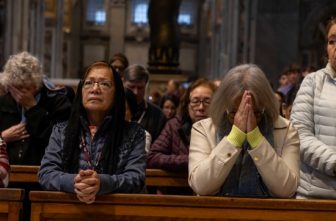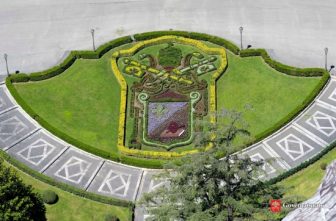
Father Austin Barnes, looking up at 10 works of sacred art recently installed on ceiling panels in St. Mary in Stillwater, explained that St. Mary Magdalene is the only one of the subjects not looking out at the viewer; rather, her eyes are lowered, trained on a Sacred Heart side shrine.
The image of St. Mary Magdalene is among those favored by Father Barnes, parochial vicar of the parish.

Identified in the Gospel of Luke as being one of the women disciples and the one to whom the resurrected Jesus first appeared, St. Mary Magdalene is depicted in this image holding a red egg. Father Barnes said tradition suggests that when St. Mary Magdalene went to Emperor Tiberius Caesar Augustus in Rome, bringing with her an egg to teach the emperor about Jesus’ resurrection, the emperor said Jesus had no more risen than the egg she brought was red. The egg immediately turned red, a color viewed in the ancient world as symbolizing life. “It’s from this that Christians have Easter eggs,” Father Barnes said.
Joining St. Mary Magdalene are depictions of St. Lucy, St. Philomena, St. Walburga and St. Hildegard. On the opposite side of the ceiling are depictions of Rachel, Miriam, Deborah, Judith and Esther. The location of the art — lining two sides of the church’s ceiling — was chosen for a “symbolic theological reason,” Father Barnes said.
“The Old Testament women are all on the north side, the darker side; they didn’t live in the fullness of revelation. … then on the south side is the (depiction of) New Testament (women) and they live on the brighter side, they live in the time of full revelation, the time of Christ.”
Father Barnes’ remarks about the holy women were punctuated by the sharp blasts of power tools, as workers installed new oak pews. The work was part of an overall renovation project in the 139-year-old church (the parish, meanwhile, is 158 years old), expected to be completed by mid-July. The last major renovation took place in the 1990s; this recent restoration has included reinforcement of the church’s foundation, new flooring, plaster repair and fresh paint. The baptismal font was relocated to the back of the nave and a confessional was moved to the narthex.
A six-person committee helped facilitate the recent work in the church; its members were Bishop Michael Izen, then-pastor; Father Barnes; Mary Wicker, trustee; Charlie Andrews, chair of the parish council; and Chris Lentz and Brenda Grubb, parishioners.
Calling it a “true team effort,” Andrews said he was grateful for “the guidance of Bishop Izen and Father Barnes throughout this whole process … their prayerful way of life helped this project from beginning to end.”
Wicker said the committee gathered feedback from parishioners prior to proceeding with the work. Andrews, who has been chair of the parish council for a few years, said the work has “been a beautiful process … some difficult decisions, some difficult conversations, but all very fruitful.”
As feedback was gathered, Father Barnes began developing ideas for design elements that would celebrate the heritage of the parish.
“I’m sitting in the church one day and I counted seven (panels along one side of the ceiling). … And I was doing some research and there are seven types of Mary,” or seven women from the Old Testament who prefigure who Mary is. “So that’s where the idea (for the sacred art) first started,” Father Barnes said.
The saints whose depictions line the south side of the ceiling are disciples, “just like Mary is the preeminent disciple,” Father Barnes said.
Father Barnes wanted the lives of these holy women to inspire parishioners and visitors, to encourage seeing the value and importance women have in the Church. “The saints, these women, are examples to us,” he said.
After much prayer and discussion, the committee selected Conrad Schmitt Studios for the sacred art project. Established in 1889 and now located in New Berlin, Wisconsin, the studio provides ecclesiastical decoration, restoration, stained glass and other art at locations throughout the United States.
At $10,000 per artwork, the committee at St. Mary chose a budget for 10 pieces rather than the full 14.
“We had to raise money to be able to commit to them; and I had a week,” to meet the artist’s timeline, Father Barnes said. “So, I set out on the task with a lot of helpers” to raise the money amid ongoing renovation fundraising.
“We were doing it ourselves; we didn’t do a capital campaign because we had just recently done one,” Wicker said.
A meeting with the St. Croix Catholic Iconographers Guild that Father Barnes attended set a series of events into motion.
“I was doing show and tell, I had printouts that I was giving to everybody and anybody, and one of the women there, she’s not a parishioner (at St. Mary) but she said, ‘I have a relic of St. Philomena. Would you like to borrow her to pray for this project?’ and I said absolutely, we would love to borrow her,” Father Barnes said.
The same day Father Barnes picked up the St. Philomena relic, he received a phone call from Sean Pilcher, a Minneapolis-based identifier and restorer of Catholic relics. A few months prior, Father Barnes had brought to Pilcher two relics a St. Mary parishioner had found with her mother’s belongings. When Father Barnes stopped by the day following the phone call, Pilcher confirmed that one of the relics was of St. Gemma Galgani; the second was of St. Lucy. Father Barnes shared his excitement with Pilcher, showing him a printout of the sacred art project that included St. Lucy. Noting St. Walburga was also part of the project, Pilcher asked Father Barnes if he wanted a relic of her as well.
“My response was ‘That’s not funny.’ Because she’s pretty obscure,” Father Barnes said. “And he said, ‘No, I have a relic of her, and you can have her.’ So, in those two days, three of the saints just showed up.” He told parishioners, “It’s an affirmation of our discernment and an affirmation that these saints are already praying for us.”
Father Barnes said in six days, the necessary funds to commit to the project were raised. “It was such a testament to the Lord’s providence and his affirmation that this is what he wanted, and he was blessing this.”
Conrad Schmitt Studios had roughly 10 artisans working on varying aspects of the project, which took a total of 12 weeks to complete, with the art itself taking about eight weeks to complete. The art was designed in the Beuronese style; the works were digitally designed, then transferred to canvas and hand painted at Conrad Schmitt Studios. They were then varnished, delivered to the church and installed with a special conservation-grade glue. Each piece is about 4 feet in diameter.
“We were really happy with our choice” in selecting the studio for the project, Wicker said, adding that the hope is the art “will be catechetical tools.”
Specifically, Andrews, 40, who attends St. Mary with his wife, Maria, and their three children, said the depiction of St. Lucy has special significance in his family — Andrews’ eldest daughter’s name is Lucy. “So that was special to us to be able to see St. Lucy up there,” Andrews said.
Father Barnes said he hopes to expand a spiritual reflection he wrote on the sacred art, possibly printing it in a coffee table book about the church. Father Barnes also hopes future parishioners will consider fundraising to install art on the other four ceiling panels; those depicted can then fully accompany parishioners and visitors as they go forth from the church’s entrance, above which is painted a verse from the Book of Judges: “If thou wilt go with me, I will go.”
“And that’s the archbishop’s call with the Synod — to go out, to bring that message, to bring that joy, that light into a world that is so dark,” Father Barnes said. He said the holy women depicted, “they’re joyful because they chose the Lord and he was providing for them.”
Father Barnes hopes the sacred art inspires “faith, awe, wonder and hope” and reminds the faithful “to trust God, to trust his providence, his plan; to not sacrifice the Lord for anything but to sacrifice everything for the Lord.”
Andrews is also “excited for the rest of the parishioners to see the beauty of St. Mary’s … to have it continue to be such a prayerful, sacred space that we can all enjoy and go to. I’m extremely excited for everyone to see it.”
UPCOMING FESTIVITIES
St. Mary is hosting a series of events to celebrate the new work done in the church:
Thursday, July 20 — A celebration of the 139th anniversary of the church’s consecration, including a 7 p.m. Solemn Mass of Blessing with guest Father Cyril Farmer.
Saturday, July 22 — Great Feast of St. Mary Magdalene, including 7 p.m. solemn vespers and Eucharistic procession with guest Msgr. Jeffrey Steenson.
Sunday, July 23 — Votive Feast of Mary, Joy of Israel, including a 10:30 a.m. solemn Mass with Bishop Michael Izen and a 12-2:30 p.m. lawn party at St. Mary’s rectory.




